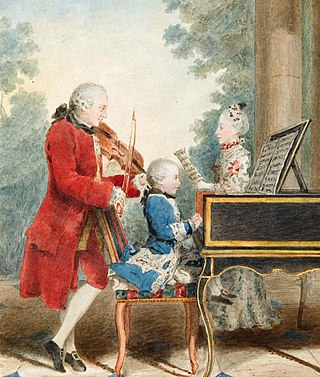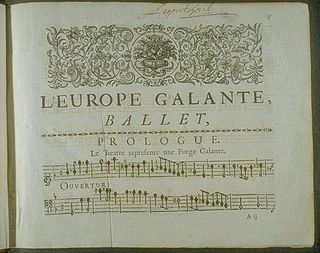
The Classical period was an era of classical music between roughly 1750 and 1820.

Johann Georg Albrechtsberger was an Austrian composer, organist, and music theorist, and one of the teachers of Ludwig van Beethoven. He was a friend of Haydn and Mozart.

Romantic music is a stylistic movement in Western Classical music associated with the period of the 19th century commonly referred to as the Romantic era. It is closely related to the broader concept of Romanticism—the intellectual, artistic and literary movement that became prominent in Western culture from approximately 1798 until 1837.

Wolfgang Amadeus Mozart was a prolific and influential composer of the Classical period. Despite his short life, his rapid pace of composition resulted in more than 800 works of virtually every genre of his time. Many of these compositions are acknowledged as pinnacles of the symphonic, concertante, chamber, operatic, and choral repertoire. Mozart is widely regarded as among the greatest composers in the history of Western music, with his music admired for its "melodic beauty, its formal elegance and its richness of harmony and texture".

A symphony is an extended musical composition in Western classical music, most often for orchestra. Although the term has had many meanings from its origins in the ancient Greek era, by the late 18th century the word had taken on the meaning common today: a work usually consisting of multiple distinct sections or movements, often four, with the first movement in sonata form. Symphonies are almost always scored for an orchestra consisting of a string section, brass, woodwind, and percussion instruments which altogether number about 30 to 100 musicians. Symphonies are notated in a musical score, which contains all the instrument parts. Orchestral musicians play from parts which contain just the notated music for their own instrument. Some symphonies also contain vocal parts.

Chamber music is a form of classical music that is composed for a small group of instruments—traditionally a group that could fit in a palace chamber or a large room. Most broadly, it includes any art music that is performed by a small number of performers, with one performer to a part. However, by convention, it usually does not include solo instrument performances.

The Piano Sonata No. 12 in F major, K. 332 (300k) by Wolfgang Amadeus Mozart was published in 1784 along with the Piano Sonata No. 10 in C major, K. 330, and Piano Sonata No. 11, K. 331. Mozart wrote these sonatas either while visiting Munich in 1781, or during his first two years in Vienna. Some believe, however that Mozart wrote this and the other sonatas during a summer 1783 visit to Salzburg made for the purpose of introducing his wife, Constanze to his father, Leopold. All three sonatas were published in Vienna in 1784 as Mozart's Op. 6.

Baldassare Galuppi was an Italian composer, born on the island of Burano in the Venetian Republic. He belonged to a generation of composers, including Johann Adolph Hasse, Giovanni Battista Sammartini, and C. P. E. Bach, whose works are emblematic of the prevailing galant music that developed in Europe throughout the 18th century. He achieved international success, spending periods of his career in Vienna, London and Saint Petersburg, but his main base remained Venice, where he held a succession of leading appointments.
Empfindsamkeit or Empfindsamer Stil is a style of musical composition and poetry developed in 18th-century Germany, intended to express "true and natural" feelings, and featuring sudden contrasts of mood. It was developed as a contrast to the Baroque Affektenlehre, in which a composition would have the same affect throughout.

A guitar solo is a melodic passage, instrumental section, or entire piece of music, pre-written to be played on a classical, electric, or acoustic guitar. In 20th and 21st century traditional music and popular music such as blues, swing, jazz, jazz fusion, rock and heavy metal, guitar solos often contain virtuoso techniques and varying degrees of improvisation. Guitar solos on classical guitar, which are typically written in musical notation, are also used in classical music forms such as chamber music and concertos.

In music, galant refers to the style which was fashionable from the 1720s to the 1770s. This movement featured a return to simplicity and immediacy of appeal after the complexity of the late Baroque era. This meant simpler, more song-like melodies, decreased use of polyphony, short, periodic phrases, a reduced harmonic vocabulary emphasizing tonic and dominant, and a clear distinction between soloist and accompaniment. C. P. E. Bach and Daniel Gottlob Türk, who were among the most significant theorists of the late 18th century, contrasted the galant with the "learned" or "strict" styles. The German empfindsamer Stil, which seeks to express personal emotions and sensitivity, can be seen either as a closely related North-German dialect of the international galant style, or as contrasted with it, as between the music of Carl Philipp Emanuel Bach, a founder of both styles, and that of Johann Christian Bach, who carried the galant style further and was closer to classical.

A Musikalisches Würfelspiel was a system for using dice to randomly generate music from precomposed options. These games were quite popular throughout Western Europe in the 18th century. Several different games were devised, some that did not require dice, but merely choosing a random number.
Music historians divide the Western classical music repertory into various eras based on what style was most popular as taste changed. These eras and styles include Medieval, Renaissance, Baroque, Classical, Romantic, Modernist, and Postmodernist. The 20th and 21st centuries are not musical eras in themselves, but are calendar periods that do not relate individually to musical history. However, these two calendar centuries can be combined into a longer musical period that includes the Modernist and Postmodernist eras. Some of the terms, such as "Renaissance" and "Baroque", are borrowed from Western art history. Approximate dates can be assigned to the beginning and ending of each of these eras, which can be useful in describing changes in taste and to estimate the style of a work composed in a particular year. However, these dates are approximate and even good approximations are hard to make.

Classical music generally refers to the art music of the Western world, considered to be distinct from Western folk music or popular music traditions. It is sometimes distinguished as Western classical music, as the term "classical music" also applies to non-Western art music. Classical music is often characterized by formality and complexity in its musical form and harmonic organization, particularly with the use of polyphony. Since at least the ninth century it has been primarily a written tradition, spawning a sophisticated notational system, as well as accompanying literature in analytical, critical, historiographical, musicological and philosophical practices. A foundational component of Western culture, classical music is frequently seen from the perspective of individual or groups of composers, whose compositions, personalities and beliefs have fundamentally shaped its history.

Baroque music refers to the period or dominant style of Western classical music composed from about 1600 to 1750. The Baroque style followed the Renaissance period, and was followed in turn by the Classical period after a short transition. The Baroque period is divided into three major phases: early, middle, and late. Overlapping in time, they are conventionally dated from 1580 to 1650, from 1630 to 1700, and from 1680 to 1750. Baroque music forms a major portion of the "classical music" canon, and is widely studied, performed, and listened to. The term "baroque" comes from the Portuguese word barroco, meaning "misshapen pearl". The works of George Frideric Handel and Johann Sebastian Bach are considered the pinnacle of the Baroque period. Other key composers of the Baroque era include Claudio Monteverdi, Domenico Scarlatti, Alessandro Scarlatti, Alessandro Stradella, Antonio Vivaldi, Tomaso Albinoni, Johann Pachelbel, Henry Purcell, Georg Philipp Telemann, Jean-Baptiste Lully, Jean-Philippe Rameau, Marc-Antoine Charpentier, Arcangelo Corelli, François Couperin, Johann Hermann Schein, Heinrich Schütz, Samuel Scheidt, Dieterich Buxtehude, and others.

Baroque music of the British Isles bridged the gap between the early music of the Medieval and Renaissance periods and the development of fully fledged and formalised orchestral classical music in the second half of the eighteenth century. It was characterised by more elaborate musical ornamentation, changes in musical notation, new instrumental playing techniques and the rise of new genres such as opera. Although the term Baroque is conventionally used for European music from about 1600, its full effects were not felt in Britain until after 1660, delayed by native trends and developments in music, religious and cultural differences from many European countries and the disruption to court music caused by the Wars of the Three Kingdoms and Interregnum. Under the restored Stuart monarchy the court became once again a centre of musical patronage, but royal interest in music tended to be less significant as the seventeenth century progressed, to be revived again under the House of Hanover. The Baroque era in British music can be seen as one of an interaction of national and international trends, sometimes absorbing continental fashions and practices and sometimes attempting, as in the creation of ballad opera, to produce an indigenous tradition. However, arguably the most significant British composer of the era, George Frideric Handel, was a naturalised German, who helped integrate British and continental music and define the future of music in the United Kingdom.

The String Quintet in E major, Op. 11, No. 5 , by Luigi Boccherini was written in 1771 and published in 1775. The quintet is famous for its minuet third movement which is frequently played as a standalone piece outside of the context of the full quintet.
Daniel Heartz (1928–2019) was an American musicologist and professor emeritus of music at the University of California, Berkeley.
Robert O. Gjerdingen is a scholar of music theory and music perception, and is an emeritus professor at Northwestern University. His most influential work focuses on the application of ideas from cognitive science, especially theories about schemas, as an analytical tool in an attempted "archaeology" of style and composition methods in galant European music of the eighteenth century. Gjerdingen received his PhD from the University of Pennsylvania in 1984 after studying with Leonard B. Meyer and Eugene Narmour. His 2007 book Music in the Galant Style, an authoritative study on galant schemata, received the Wallace Berry award from the Society for Music Theory in 2009 and has become influential in the field of music theory. Gjerdingen was also editor of the journal Music Perception from 1998 to 2002.

The transition from the classical period of European Art music, which lasted around 1750 to 1820, to Romantic music, which lasted around 1800 to 1910, took place in the eighteenth and nineteenth centuries. Composers began transitioning their compositional and melodic techniques into a new musical form which became known as the Romantic Era or Romanticism due to the implementation of lyrical melodies as opposed to the linear compositional style of Classical music.














